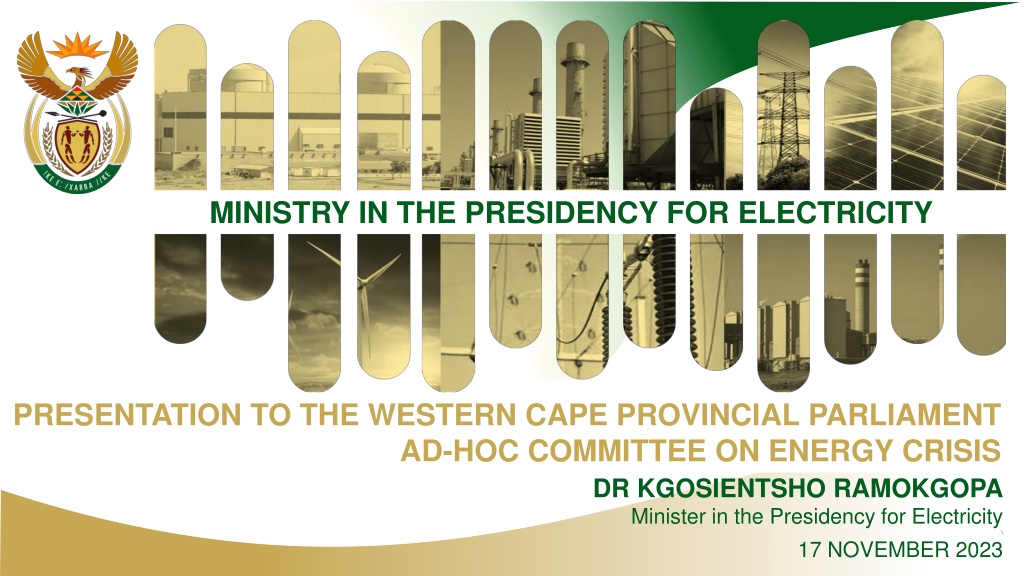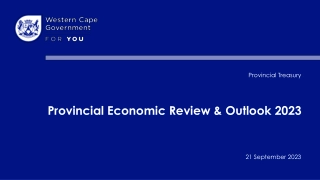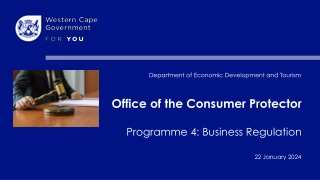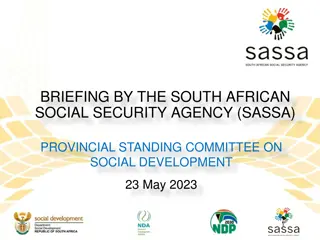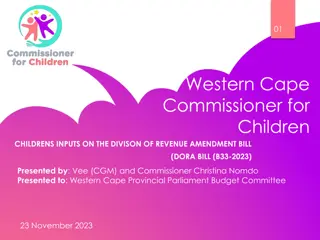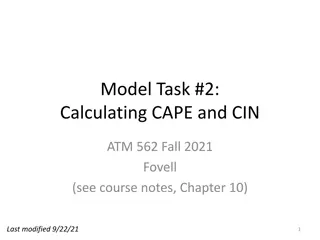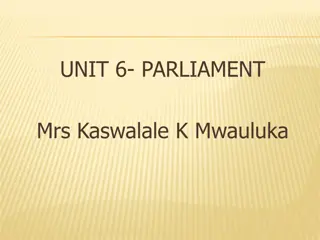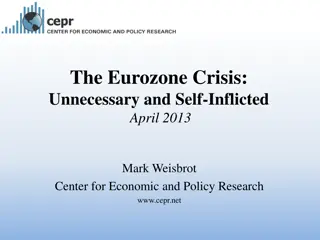Presentation on Energy Crisis Impact and Energy Action Plan for Western Cape Provincial Parliament
Minister in the Presidency for Electricity, Dr. Kgosientsho Ramokgopa, presented on the economic impact of load shedding and high input costs on the economy, emphasizing the negative effects on company profitability, job security, tax collection, and service delivery. The presentation highlighted the significant influence of load shedding on total real GDP growth and the most affected sectors. Additionally, the Energy Action Plan (EAP) was outlined, focusing on priorities such as fixing Eskom, enabling private investment, accelerating procurement of new capacity, unleashing investment in rooftop solar PV, and transforming the electricity sector. The overview of Eskom's generation performance from May 2023 to October 2023 was also provided.
Download Presentation

Please find below an Image/Link to download the presentation.
The content on the website is provided AS IS for your information and personal use only. It may not be sold, licensed, or shared on other websites without obtaining consent from the author. Download presentation by click this link. If you encounter any issues during the download, it is possible that the publisher has removed the file from their server.
E N D
Presentation Transcript
MINISTRY IN THE PRESIDENCY FOR ELECTRICITY PRESENTATION TO THE WESTERN CAPE PROVINCIAL PARLIAMENT AD-HOC COMMITTEE ON ENERGY CRISIS DR KGOSIENTSHO RAMOKGOPA Minister in the Presidency for Electricity 17 NOVEMBER 2023 \
PROBLEM STATEMENT: ECONOMIC LOADSHEDDING IMPACT ON THE ECONOMY Loadshedding & high input costs, e.g. electricity & fuel costs, continue to erode company profitability compromising jobs; spillover effects on tax collection and service delivery capacities SARB modelling probes the economic impact from 2014 to 2022 based on load-shedding intensity Load-shedding exerts a statistically significant negative impact on total real GDP growth: estimated between R204m and R899m daily Most affected sectors: agriculture, forestry and fishing; manufacturing; mining; and transport, storage and communication Q3 2022: Reduced quarterly real GDP growth by 2.1 percentage points* *unadjusted load-shedding intensity index exhibited record high of 3 736 GWh Q3 2022: 2.3 percentage point decrease in quarterly real GDP growth* *load-shedding intensity index was at 1 692.5 GWh adjusting for weekends, public holidays and non-conventional working hours
RECAP: ENERGY ACTION PLAN (EAP) PRIORITY OUTCOMES Cross-cutting workstreams Outcomes Delivery workstreams Outcome 1: Fix Eskom and improve the availability of existing supply Improving Eskom Plant Performance Outcome 2: Enable private investment in new generation capacity Data Analytics and Research Procurement and Financing Accelerating New Generation Capacity (including private investment and SSEG) Legal and Regulatory Communications Outcome 3: Accelerate procurement of new capacity from renewables, gas and battery storage Demand Management Security of Infrastructure Outcome 4: Unleash investment in rooftop solar PV for businesses and households Distribution Outcome 5: Transform the electricity sector to achieve energy security Transmission
OVERVIEW OF ESKOM GENERATION PERFORMANCE MAY 2023 - OCTOBER 2023 35000 20000 18000 30000 16000 25000 14000 12000 20000 10000 15000 8000 6000 10000 4000 5000 2000 0 May-23 Baseline Jun-23 Jul-23 Aug-23 Sep-23 Oct-23 Jun-Oct 2023 Average 0 May-23 Baseline Jun-23 Jul-23 Aug-23 Sep-23 Oct-23 Jun-Oct 2023 Average UCLF, Partial Losses & outage delays (MW) Partial Load Losses (MW) Capacity Available (MW) p.m. peak forecasted (MW) Planned outages (MW) Outage Slip (MW)
OVERVIEW OF ESKOM GENERATION PERFORMANCE AS AT OCTOBER 2023 Capacity Available (MW) Planned outages (MW) UCLF, Partial Losses & outage delays (MW) p.m. peak forecasted (MW) Date Partial Load Losses (MW) Units at Risk (MW) Outage Slip (MW) (08:00 daily) Average 02-06 Oct 2023 Average 09-13 Oct 2023 Average 16 - 20 Oct 2023 Average 23 - 27 Oct 2023 Avergae 30-Oct - 03-Nov 23 28268 5381 14113 6596 27491 5235 1148 28962 5368 13373 6878 27903 4835 766 29418 5207 13096 6415 27879 4158 1409 28103 4478 14998 6672 26793 3903 1933 27398 3619 17033 5907 27571 3549 3657 28430 4810 14523 6494 27527 4336 1783 M-T-D Avg
KUSILE - CRITICAL PATH Kusile remains on the critical path to restoring the supply-demand balance. KUSILEUNIT 4 800 MW KUSILEUNIT 3 800 MW KUSILEUNIT 1 800 MW KUSILEUNIT 2 800 MW Original Date 11-Dec 2023 Original Date 28-Nov 2023 Revised Date 14 Oct 2023, Returned on 29 Sep 2023 Original Date 24-Dec 2023 Planned Date 17-Sep 2023, returned as planned. Revised Date 30-Oct 2023 Revised Date 30-Nov 2023 KUSILE UNITS 1-5 4000 MW KUSILEUNIT 5 800 MW KUSILEUNIT 6 800 MW MEDUPI UNIT 4 800 MW Original Date 28-Oct 2023 Planned synchronization date September 2024 Planned return to service June 2024 Between Sep Dec 2023 Revised Date 30 Dec 2023
ACCELERATING ENERGY PROJECTS The Embedded Generation Task Team supports over 100 projects to clear regulatory hurdles and enter construction as quickly as possible. DEPARTMENT Environmental Consent REGULATORY APPROVAL PREVIOUS TIMEFRAME REVISED TIMEFRAME DFFE Scoping and Environmental Impact Assessment (EIA) Basic Assessment (BA) Atmospheric Emissions Licence (AEL) 150 days and 90 days appeal period 107 days and 90 days appeal period Process underway to exempt solar PV and battery storage in areas of low and medium sensitivity Embedded generation projects classified as Strategic Integrated Project (SIPs), reducing timeframe to 57 days DWS General Authorisations (GA) Water Use License (WUL) Over 300 days for WUL and GA Notice gazetted to require only a GA for wind, solar PV and battery storage projects with 90 days timeframe for water use license applications Grid Connection Eskom Cost Estimate Letter 90 days 50 days Eskom Budget Quotation 6 months 4 months NERSA Registration 3 months 19 days Land Access DALRRD Subdivision of Agricultural Land Act consent of land use authorisation 90 days 30 days DMRE Section 53 approval No specific timeframes 60 days DPWI Any servitudes or options registered or to be registered in favour of the Project Company and/or Eskom over the project sites No specific timeframes 94 days
ACCELERATING ENERGY PROJECTS The Embedded Generation Task Team is supporting over 100 projects to clear regulatory hurdles and enter construction as quickly as possible. A survey of project developers conducted by Eskom and the South African Wind Energy Association (SAWEA), and the South African Photovoltaic Industry Association (SAPVIA) shows that 66 GW of wind and solar projects are in developmentacross the country. This demonstrates a robust pipeline of private sector investment in new-generation capacity. Strengthening the transmission network will be key to enabling this investment.
INDEPENDENT POWER PRODUCER PROGRAMME CURRENT STATUS Achievements to date Capacity procured since August 2020: 5.58 GW Legal Close:2 112 MW (5 RMIPPPP and 19 BW5 Projects) In Construction: 1 159 MW (5 RMIPPPP and 9 BW5 Projects) New Preferred Bidders: 1 000 MW (REIPPPP BW 6) RMIPPP, BW5 & 6 BW 1- 4 Plans for remainder of 2023-24 Total MW in Operation Battery Energy Storage BW 1. Bid Submission on 2 August 17 bids received. Evaluation in progress BW 7 RFP to be released to market (target Q2)= 5 000 MW Gas RFP to be released to market (target Q2) = 3 000 MW Battery Energy Storage BW 2 = 1 231MW (target Q4) Gas BW2 = 1 000MW (target Q4) Remaining RMIPPPP Projects to Legal Close and Commercial Close by no later than December 2023 Remaining BW 5 Projects to Commercial Close by Dec 2023 6 180 MW from 90 RE Projects New Roll-out
LOAD REDUCTION INTERVENTION UPSCALING ROOFTOP SOLAR PV & SOLAR WATER HEATING Approximately 500,000 burst electric geysers are replaced in SA per annum by banks and insurers on bonded houses. Of the 4 million residential deeds, there are 2.5 million active bonds. A partnership with Financial Services has the potential to accelerate market implementation. ROOFTOP SOLAR PV SOLAR WATER HEATERS Upscaling businesses & households investment in rooftop Solar PV Replacement of Electric Geysers with Solar Water Heaters in residential households Increase the replacement of electric geysers with solar water heaters (SWH) in residential households through partnering with the insurance industry and banks; and Scale up the installation of rooftop solar PVs for residential and commercial use (distributed energy generation). Government Interventions : The solar panel tax incentive and the Energy Bounce-Back Loan Scheme Areas of Development: Manufacturing capacity to meet the demand for solar energy generation and storage components; and Anticipated increase in the demand for solar installation capacity.
ENERGY ACTION PLAN A FOCUS ON DEMAND SIDE INTERVENTIONS INSURANCE AND BANKING SECTOR RESIDENTIAL MARKET OVERVIEW Upscaling the uptake of energy efficient solutions needs to be aided by a significant (i) increase in stock management and ability for (ii) human capital to meet the demand and support to ensure (iii) financing is more inclusive Geysers / water heating consumes the greatest amount of electricity which drives peak demand i.e. between 30%-50% of household consumption For every 10 insurance claims, 1 electric geyser is replaced with a solar water heater that has an upfront cost i.e. 10% of insurance claims The current take-up of rooftop solar is estimated at less than 5%; For every 1000 households that install a medium sized system, 5MW of power is taken of the grid. To reduce 1 stage of load shedding, or 1000MW, 200 000 HHs to implement a similar system. SKILLS Installation Capacity SUPPLY Solar System Components 200 000 HOUSEHOLDS 1 STAGE LOAD-SHEDDING Install medium sized solar system Can Be Reduced
ELECTRICITY DISTRIBUTION INDUSTRY Global trends disrupting EDI Energy markets, Lender preference Bilaterals Democratisation Decarbonisation ERA: TSO, Aggregators, Paris Agreement Traders IRP 2019, REIPPP, Requires a neutral License reprieve facilitator Load shedding, PV Explosion of the proliferation wheeling business Bi-directional energy - technical challenge IPPs are on Dx grid Dx grid unable to Rooftop PV, Own integrate DERs Generation Grid and systems Most economical modernization Digitalisation Technology LV Visibility Decentralisation disruptors, DERs
SUPPORTING INVESTMENT IN PRIVATE GENERATION THE FOCUS IS ON NET BILLING, FEED-IN TARIFFS AND WHEELING. The development of a net billing framework has been complete, and is regulator, NERSA, for adoption as rules. The development of the wheeling framework is well advanced, and will be submitted to NERSA shortly Work on the options to achieve a standardized feed-in-tariff approach is underway there are greater regulatory and system complexities than for net-billing with the legal, Net billing framework wheeling framework feed-in-tariff approach 14
ELECTRICITY DISTRIBUTION INDUSTRY Key challenges facing distribution industry Systemic challenges Future Revenue depends on Policy Funding Solutions for transitioning Municipality Debt Advocacy for municipalities to pay for electricity or lose license Advocacy for the Active Partnering Program Strategic Partnerships Constrained Balance Sheet Limited Capex Explore strategic funding opportunities Industry Transformation Dx is critical to the future ESI, Provides security to the grid Enables a liberalized market 1 4 7 Decarbonise, Decentralise Digitalise, Democratise Energy Losses Energy Losses is not just a Dx problem. Requires organisation synergy and shareholder intervention. Policy & Regulation Advocacy for DSO-DET to be licensed Licensing of rooftop PV, microgrids Tariff unbundling, green energy Sales Decline vs Revenue Augmentation Load shedding - grid defection. Revenue augmentation: Wheeling, DSO-DET, Green energy, E-mobility 8 2 5 Enable IPP, DERs connections, Grid modernisation, Security of Supply, Enable IRP and JET Inability to respond to new energy market due to inflexible grid, loss of potential income and customers Income vs Cost of Sales Advocacy for cost-reflective tariffs. Transfer Pricing 3 6 Creating value for customers - Enabling customers to trade and lower energy costs
ELECTRICITY DISTRIBUTION INDUSTRY Case for change re-imaging the distribution industry is critical to energy security South African Energy Crisis Demand exceeds supply. New Gen is fast-tracked. 01 Tax reprieve for business and households to establish own generation. Economy damaged The ESI is restructuring and has consequences for the EDI New Developments: System Operator, Central Purchasing Agency, Energy Markets, NERSA licenses Traders and Aggregators, DMRE lifts license threshold for own gen, DTICC promotes energy communities 02 The EDI is critical to solving the energy crisis Most IPPs are connected on the Dx grid. DERs such as rooftop solar, customer own gen, demand response programs, energy efficiency, load curtailment. DX provides these solutions and grid access 03 An unstable, volatile EDI Eskom faces revenue recovery challenges. 04 Municipalities raised as risk by Auditor General. Municipal networks in poor condition. The Private Sector is cherry-picking while the utility model is being eroded Utilities dilute risk by having a mix of good paying, high volume customers with lower and risky customers. The Private Sector is being licensed to be traders, aggregators, and generators and is setting up wheeling and bilateral contracts 05
TRANSMISSION TRANSMISSION LANDSCAPE Transmission infrastructure is concentrated in the in- land Provinces (Gauteng, Limpopo and Mpumalanga 7 Grids cover 9 Province 33217km of high voltage / extra high voltage (HC/EHC) Lines 160 194 MVA installed transformer capacity 572 Transformers | 170 Substations 3197 Employees With generation stabilizing, work must continue to and strengthen and expand our national transmission infrastructure
PLANNED INFRASTRUCTURE REQUIREMENTS Eskom Transmission circuit-km built per year 325% increase in Transmission infrastructure is required in the next 10-years 14 218 circuit km is 43% of current 33 000 circuit km
PLANNED INFRASTRUCTURE REQUIREMENTS GRID CAPACITY IN CONSTRUCTION Several improve generation connection capability, over and above the two priority programs projects in execution The following Projects will deliver 2,335MW of new grid capacity: Aries Upington 400kV Juno Gromis 400kV line Poseidon Pembroke 400kV line Transformers at Nama, Kronos and Upington 400 kV 765 kV
SUMMARY: THE IMPACT OF ENERGY INFRASTRUCTURE IN DRIVING GROWTH CASE STUDY: SOUTH AFRICA S TRANSMISSION INFRASTRUCTURE DEVELOPMENT PLAN FACILITATING RENEWABLE ENERGY DEPLOYMENT Tx infrastructure plays a vital role in integrating renewable energy sources into the grid Robust transmission networks enable the efficient transportation of renewable energy across regions, unlocking the potential for significant economic growth 01 ATTRACTING INVESTMENTS AND BUSINESS GROWTH 02 Industries require a stable and ample power supply to operate efficiently and expand their operations Regions with well-developed transmission networks are often favoured by investors, as they offer the necessary infrastructure to support business growth JOB CREATION AND ECONOMIC OPPORTUNITIES 03 Construction, operation and maintenance of transmission lines and associated infrastructure require a skilled workforce Transmission infrastructure development projects have the potential to generate significant employment and localisation opportunities TECHNOLOGICAL ADVANCEMENTS AND INNOVATION 04 Transmission infrastructure development often incorporates technological advancements, such as smart grid technologies and digitalization Adoption of advanced technologies in transmission infrastructure drives, fosters a conducive business environment, and attracts investments in related sectors
